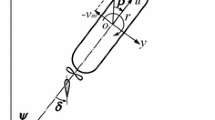Abstract
In this study, a dynamic modeling method for foil-like underwater vehicles is introduced and experimentally verified in different sea tests of the Hadal ARV. The dumping force of a foil-like underwater vehicle is sensitive to swing motion. Some foil-like underwater vehicles swing periodically when performing a free-fall dive task in experiments. Models using conventional modeling methods yield solutions with asymptotic stability, which cannot simulate the self-sustained swing motion. By improving the ridge regression optimization algorithm, a grey-box modeling method based on 378 viscous drag coefficients using the Taylor series expansion is proposed in this study. The method is optimized for over-fitting and convergence problems caused by large parameter matrices. Instead of the PMM test data, the unsteady computational fluid dynamics calculation results are used in modeling. The obtained model can better simulate the swing motion of the underwater vehicle. Simulation and experimental results show a good consistency in free-fall tests during sea trials, as well as a prediction of the dive speed in the swing state.
Similar content being viewed by others
References
Antes, H. and Panagiotopoulos, P.D., 1992. The Boundary Integral Approach to Static and Dynamic Contact Problems, Birkhauser, Basel.
Cao, L. S., Zhu, J. and Wan, W. B., 2016. Numerical investigation of submarine hydrodynamics and flow field in steady turn, China Ocean Engineering, 30(1), 57–68.
Chen, C.W., Kouh, J.S. and Tsai, J.F., 2013. Maneuvering modeling and simulation of AUV dynamic systems with Euler-Rodriguez quaternion method, China Ocean Engineering, 27(3), 403–416.
Cooney, L.A., 2009. Dynamic Response and Maneuvering Strategies of a Hybrid Autonomous Underwater Vehicle in Hovering, MSc. Thesis, Massachusetts Institute of Technology, Cambridge, MA.
Gertier, M. and Hagen, G.R., 1967. Standard Equations of Motion for Submarine Simulation, Technical Report AD 653861, David W Taylor Naval Ship Research and Development Center, Bethesda MD.
Hoerl, A.E. and Kennard, R.W., 1970. Ridge regression: biased estimation for nonorthogonal problems, Technometrics, 12(1), 55–67.
Hoerl, A.E. and Kennard, R.W., 1970. Ridge regression: applications to nonorthogonal problems, Technometrics, 12(1), 69–82.
Jakuba, M.V., 2003. Modeling and Control of An Autonomous Underwater Vehicle with Combined Foil/Thruster Actuators, MSc. Thesis, Massachusetts Institute of Technology and Woods Hole Oceanographic Institution, Woods Hole, MA.
Ji, D.X., Song, W., Zhao, H.Y. and Liu, J., 2016. Deep sea AUV navigation using multiple acoustic beacons, China Ocean Engineering, 30(2), 309–318.
Li, H., Li, Z.W. and Cui, W.C., 2013. A preliminary study of the resistance performance of the three manned submersibles with full ocean depth, Journal of Ship Mechanics, 17(12), 1411–1425.
Liu, H., Ma, N. and Gu, X.C., 2016. Numerical simulation of PMM tests for a ship in close proximity to sidewall and maneuvering stability analysis, China Ocean Engineering, 30(6), 884–897.
Maalouf, D., Chemori, A. and Creuze, V., 2015. φ 1 adaptive depth and pitch control of an underwater vehicle with real-time experiments, Ocean Engineering, 98, 66–77.
Martin, S.C. and Whitcomb, L.L., 2014. Experimental identification of six-degree-of-freedom coupled dynamic plant models for underwater robot vehicles, IEEE Journal of Oceanic Engineering, 39(4), 662–671.
Murashima, T., Nakajoh, H., Takami, H., Yamauchi, N., Miura, A., Ishizuka, T. and Enterprises, N.M., 2009. 11,000m class free fall mooring system, OCEANS 2009-EUROPE, IEEE, Bremen, Germany, pp. 9–13.
Prestero, T., 2001. Verification of a Six-Degree of Freedom Simulation Model for the REMUS Autonomous Underwater Vehicle, Ph. D. Thesis, Massachusetts Institute of Technology and Woods Hole Oceanographic Institution, Woods Hole, MA.
Wang, C.F., Zhang, F.M. and Schaefer, D., 2015. Dynamic modeling of an autonomous underwater vehicle, Journal of Marine Science and Technology, 20(2), 199–212.
Xu, H.L., Gao, L., Liu, J., Wang, Y.Q. and Zhao, H.Y., 2015. Experiments with obstacle and terrain avoidance of autonomous underwater vehicle, OCEANS 2015-MTS/IEEE Washington, IEEE, Washington DC, USA, pp. 1–4.
Yang, R., Clement, B., Mansour, A., Li, M. and Wu, N.L., 2015. Modeling of a complex-shaped underwater vehicle for robust control scheme, Journal of Intelligent &Robotic Systems, 80(3–4), 491–506.
Yoon, H.K. and Rhee, K.P., 2003. Identification of hydrodynamic coefficients in ship maneuvering equations of motion by Estimation-Before-Modeling technique, Ocean Engineering, 30(18), 2379–2404.
Liu, Z.Y., Xu, Q.N., Liu, T. and Chen J.P., 2000. Analytical formulation of AUV unpowered diving steady motion, Proceedings of the 2000 International Symposium on Underwater Technology, IEEE, Tokyo, Japan, pp. 177–180.
Zou, K.H., Tuncali, K. and Silverman, S.G., 2003. Correlation and simple linear regression, Radiology, 227(3), 617–622.
Acknowledgements
The authors wish to thank all other members of the project Hadal ARV for their help.
Author information
Authors and Affiliations
Corresponding author
Additional information
Foundation item: This research was financially supported by the National Key R & D Program of China (Grant No. 2016YFC0300802) and the Strategic Priority Research Program of the Chinese Academy of Sciences (Grant No. XDB06050200).
Rights and permissions
About this article
Cite this article
Liu, Xy., Li, Yp., Wang, Yx. et al. Hydrodynamic modeling with grey-box method of a foil-like underwater vehicle. China Ocean Eng 31, 773–780 (2017). https://doi.org/10.1007/s13344-017-0088-0
Received:
Revised:
Accepted:
Published:
Issue Date:
DOI: https://doi.org/10.1007/s13344-017-0088-0




